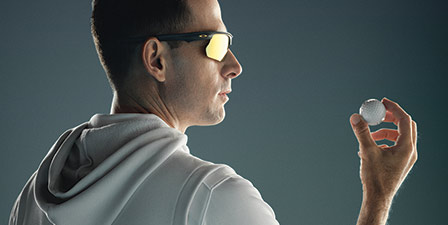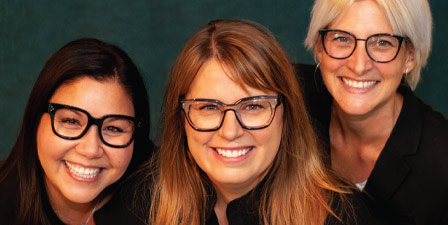A 20/20 EXCLUSIVE WITH TURA'S VICE PRESIDENT OF BRAND MANAGEMENT JENNIFER COPPEL ON HER DESIGNS AND FUTURE OF EYEWEAR
By Jillian Urcelay
JU: How did you get your start in the eyewear industry?
JC: Let me start by explaining that my journey to eyewear has been untraditional. I did not study industrial design or accessories design as many others. Rather, my Master’s degree is in metalsmithing and my Bachelor’s degree in jewelry making. I am a craftsman at heart and love working with my hands in a detailed and meticulous fashion. I studied at Cranbook Academy of Art, where I learned the psychological impact of living with well-made, well-designed daily objects that make our lives easier and more enjoyable. After graduating, I started my own company designing and manufacturing door and cabinet hardware, which I sold to interior designers, architects and private clients. After September 11, I decided to close my business and move to NYC where I entered the commercial design world. I designed and developed home accessories for 10 years from the mass market to the luxury level, expanding my knowledge of product design, materials and sourcing, falling in love with international development and travel.
In early 2009, I was hired by David Friedfeld to lead the product team at ClearVision Optical. It was an exciting opportunity, and I had a strong affinity for eyewear and predicted that many of my talents and interests would be showcased in this new product category. I would be able to design beautiful, functional, important necessities, no more frivolous “landfill” as I did in some of my earlier commercial work. I love that eyewear is a medical device first and a vehicle for self-expression. Knowing that I help people see keeps me grounded in this industry.
In 2012, when Scott Sennett offered me the opportunity to lead the Brand Management team for Tura, to head all product and marketing efforts for the company, I was excited by the new creative challenge and the option to work in NYC again. He was trusting me to restore Tura’s former image as a strong design house through exceptional product collections, through high fashion marketing images and by growing our strategic licensor partnerships. I feel very proud of accomplishing this goal and thankful for this amazing opportunity. And now, I am even more grateful, as Tura has remained strong through the pandemic. Thank goodness I design fashionable medical necessities, and I have a job where my devotion to beautiful functional objects has come full circle.
How do you describe your personal style? Does this ever shine through
in your designs or are they
two separate entities?
My personal style has always had a slight edge. As a teenager, I was punk rock to the core. In college, I only wore vintage dresses, concert T-shirts and overalls. As I matured, I wanted to keep my edge and became obsessed with a more rockabilly pin-up style (red lipstick and Bettie Page bangs). After moving to NYC in 2002, I enjoyed discovering the new indie brands that were popping up all over the Lower East Side, Noho and Brooklyn. I think it was only then that I started to find my own style, which today still reflects my past loves, including the red lipstick, but has a decidedly more modern and sophisticated perspective. I am passionate about discovering fresh innovative ideas, and I think this fervor for the hunt strongly informs my design process. While I am rarely designing for myself, this research informs what I ultimately consider “good design” regardless of the brand identity. The creativity of these new designers inspires me to never settle and to continue to pursue a strong forward-thinking vision (no pun intended).
For you in particular, what are the
big influences or inspirations that you look toward when designing eyewear?
There is an adage that eyewear is simply “two holes and two sticks.” I love the challenge of finding new ways to express two holes and two sticks every season. There are so many different aspects to eyewear design: trend, shape, color development, technical innovations, material combinations and it is always evolving. Just this week I looked at the trend presentations my team prepared for the past four years, and it was obvious how much eyewear design has changed. It continually becomes more elevated in its use of materials and more elaborate in its engineering and construction. To improve in these areas every season, I need to look at a wide set of influences. I look at furniture, architecture, jewelry, apparel, accessories, food and of course, eyewear brands that I admire. I am still an avid vintage shopper and flea market connoisseur. I love referencing vintage eyewear and retro-kitsch inspirations. On weekends I also scout and photograph graffiti and street art. Street art often defines what is important and relevant today, and it provides early pop-culture clues that eventually inform fashion design. I am inspired by creative genius, and thankfully, living in Brooklyn, I can find it just about everywhere.
Which of Tura’s brands do you most enjoy working on and why?
Working on the Gwen Stefani brands is creatively very gratifying. We can be so expressive with color, material and shape. And I can reference that punk rock ska loving teenager deep down inside. I believe many of our strongest and most exciting designs land in her collections. However, I have a personal affinity for Mini Eyewear and Kate Young for Tura. These are the two brands I personally wear, and it is always easiest to design for myself. Both brands are fashion forward, chic and edgy. With Mini, we can be very experimental in shape and sophisticated in construction. Kate shares my love for vintage, and she has amazing taste. She has taught me so much about fashion, personal style and the definition of chic. Together, we find vintage frames that for one reason or another feel relevant today, and we update them to be fashion forward.
What general direction do you see
eyewear moving toward in terms
of shapes, materials, technology,
production, etc.?
Eyewear is having a strong moment. While many of the effects of the pandemic have been devastating, the need for eyewear is stronger than ever. Now that many people work from home, their opportunity to express their personal style is limited to shoulders and up. Essentially, the face has become the focus of our fashion style. And even out in public, due to mask wearing, all one can see is everyone’s eyes. So eyewear, now more than ever, is essential for self-expression. I think this cultural shift is going to have a lasting effect on eyewear design. As we finalized many of our 2021 styles during the height of the pandemic, we asked ourselves what matters now to consumers. We made sure to include an assortment of bold, fashion-forward “Zoom Statement” frames, and light and comfortable “Comfy Sweatpants” frames for when one is off camera in each collection.
I also think the topic of sustainability is finally becoming more important to the eyewear community. At Tura, we are focusing on how to lower our carbon footprint, especially in our eyewear manufacturing processes. This is a complex journey, and I admire the many small eyewear brands that are pursuing this effort with admirable transparency. While using biodegradable acetate is a great first step, it is a very small step, as acetate is one of the most wasteful materials we can use for manufacture. It requires a deductive manufacturing process, so more than 80 percent of the material goes to waste. Moving forward, we are testing recycled injected materials. With an injection process, there is very little waste. In addition, we hope to re-use other plastics that would normally go to a landfill.
Anything else you would like to share about what’s coming next? Any new initiatives or exciting news for Tura?
In my past eight years at Tura, we have launched eight brands. So it is time to take a break from new launches and focus more internally. 2020 has been a year of deep reflection for many companies. We have been assessing what is important and where we should focus on our energy. At Tura, we are expanding many of our collections in size, fit and styling. We have always had a strong reputation for having more inclusive sizing and a large variety of fits. We are expanding these efforts even further to address the fit and styling needs of everyone in the U.S. Many companies standardize their “fit” as it makes it much easier for junior designers to follow. However, we intensely focus on having a variety of fits as nobody has the same bridge, the same nose flare or the same head fit. 2020 has highlighted the beauty of our country’s diversity, and Tura is dedicated to making sure everyone looks and feels amazing in their glasses, regardless of their ethnicity, size or fit needs.






















